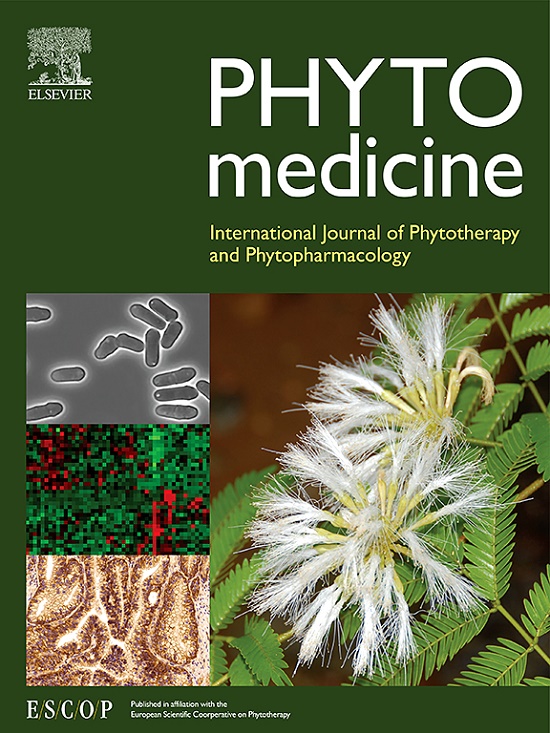Effects of Rhaponticum carthamoides (Willd.) Iljin on endothelial dysfunction and the inflammatory response in type 2 diabetes mellitus mice
IF 6.7
1区 医学
Q1 CHEMISTRY, MEDICINAL
引用次数: 0
Abstract
Background
Diabetes mellitus (DM) and its complications seriously threaten human life and health. Rhaponticum carthamoides (Willd.) Iljin (RC) is widely used to treat cardiovascular diseases. Previous studies reported that RC reduces blood glucose levels in rats with type 1 DM. However, the effects of RC on type 2 diabetes and vascular complications, as well as its related active components and underlying mechanisms, remain unclear.
Purpose
This study aimed to investigate the effects of RC on endothelial dysfunction and the inflammatory response in type 2 DM mice and to explore its underlying mechanism and active ingredients.
Study Design/Methods
Male C57BL/6J mice were used to establish a type 2 DM mouse model. After 12 weeks of oral administration of RC extract (60, 120, and 240 mg/kg) to mice, blood glucose and lipid levels were assessed. The morphological structures of the liver and kidney tissues were observed using hematoxylin and eosin (HE) staining, and their functions were evaluated by detecting relevant biochemical indicators in the serum. Then, aorta morphology was observed via HE staining. In addition, serum levels of markers of endothelial function and inflammatory factors were detected, and the expression of inflammatory factors and the phosphorylation levels of key proteins in the aorta were examined. Furthermore, prediction and enrichment analyses of potential targets of RC acting on diabetic vascular lesions were performed on the basis of pharmacophore matching using various databases. Then, the expression, localization and phosphorylation levels of potential targets in the aortas of DM mice treated with RC were assessed using Western blotting, immunofluorescence, and RT‒PCR. Finally, the active components of RC were identified through virtual screening, and their ability to improve endothelial cell dysfunction was verified.
Results
RC reduced blood glucose levels and serum lipid levels of total triglyceride (TG), total cholesterol (TC), and low density lipoprotein cholesterol (LDL-c), increased high density lipoprotein cholesterol (HDL-c) levels, and improved liver and kidney function in type 2 DM mice. RC decreased endothelial cell shedding in the aortas of type 2 DM mice, increased serum nitric oxide (NO) and nitric oxide synthase (NOS) levels, and reduced soluble cluster of differentiation 40 ligand (sCD40L), tumor necrosis factor α (TNF-α), and interleukin-1β (IL-1β) levels. Further findings indicated that RC reduced the expression of aortic inflammatory factors, namely, CD40, CD40L, IL-1β, and interleukin-6 (IL-6), and increased endothelial NOS (eNOS) phosphorylation levels. Sirtuin 6 (SIRT6), protein kinase B (AKT), and eNOS were predicted to be key node targets of RC acting on DM vascular lesions, and it was confirmed that RC increased SIRT6 expression and AKT phosphorylation levels in aortic endothelial cells. 20-Hydroxyecdysone (20E), daucosterol (Dau), euscaphic acid (Eus), and syringin (Syr) were identified as active components of RC. These components protect against TNF-α-induced human umbilical vein endothelial cell (HUVEC) damage and decrease the release of lactate dehydrogenase (LDH) and IL-1β and increased the release of NO in TNF-α-induced HUVECs in a dose-dependent manner.
Conclusion
RC reduced blood glucose and lipid levels in mice with type 2 DM and protected liver and kidney function. RC promotes SIRT6 expression in endothelial cells; upregulates the NO/NOS system by increasing AKT/eNOS phosphorylation levels to regulate vascular tone factors; and reduces the levels of inflammatory factors such as CD40, TNF-α, and IL-1β to inhibit endothelial inflammatory responses. Based on these mechanisms, RC improves endothelial dysfunction.
伊尔金对 2 型糖尿病小鼠血管内皮功能障碍和炎症反应的影响
背景糖尿病(DM)及其并发症严重威胁着人类的生命和健康。Rhaponticum carthamoides (Willd.) Iljin(RC)被广泛用于治疗心血管疾病。先前的研究报告称,RC 可降低 1 型糖尿病大鼠的血糖水平。本研究旨在探讨 RC 对 2 型 DM 小鼠血管内皮功能障碍和炎症反应的影响,并探索其潜在机制和活性成分。研究设计/方法采用雄性 C57BL/6J 小鼠建立 2 型 DM 小鼠模型。小鼠口服 RC 提取物(60、120 和 240 毫克/千克)12 周后,评估血糖和血脂水平。使用苏木精和伊红(HE)染色法观察肝脏和肾脏组织的形态结构,并通过检测血清中的相关生化指标评估其功能。然后,通过 HE 染色观察主动脉形态。此外,还检测了血清中内皮功能和炎症因子的标志物水平,并检查了主动脉中炎症因子的表达和关键蛋白的磷酸化水平。此外,在药理匹配的基础上,利用各种数据库对作用于糖尿病血管病变的 RC 潜在靶点进行了预测和富集分析。然后,利用 Western 印迹、免疫荧光和 RT-PCR 技术评估了潜在靶点在接受 RC 治疗的 DM 小鼠主动脉中的表达、定位和磷酸化水平。结果RC降低了2型DM小鼠的血糖水平和血清脂质总甘油三酯(TG)、总胆固醇(TC)和低密度脂蛋白胆固醇(LDL-c)水平,提高了高密度脂蛋白胆固醇(HDL-c)水平,并改善了肝肾功能。RC 可减少 2 型糖尿病小鼠主动脉内皮细胞脱落,提高血清一氧化氮(NO)和一氧化氮合酶(NOS)水平,降低可溶性分化簇 40 配体(sCD40L)、肿瘤坏死因子α(TNF-α)和白细胞介素-1β(IL-1β)水平。进一步的研究结果表明,RC 降低了主动脉炎症因子(即 CD40、CD40L、IL-1β 和白细胞介素-6(IL-6))的表达,并提高了内皮 NOS(eNOS)的磷酸化水平。据预测,Sirtuin 6(SIRT6)、蛋白激酶 B(AKT)和 eNOS 是 RC 作用于 DM 血管病变的关键节点靶标,研究证实,RC 增加了主动脉内皮细胞中 SIRT6 的表达和 AKT 磷酸化水平。20-羟基蜕皮激素(20E)、龙葵甾醇(Dau)、葫芦巴酸(Eus)和鞘氨醇(Syr)被确认为 RC 的活性成分。结论 RC 能降低 2 型糖尿病小鼠的血糖和血脂水平,保护肝肾功能。RC 可促进内皮细胞中 SIRT6 的表达;通过提高 AKT/eNOS 磷酸化水平上调 NO/NOS 系统,从而调节血管张力因子;降低 CD40、TNF-α 和 IL-1β 等炎症因子的水平,从而抑制内皮炎症反应。基于这些机制,RC 可改善内皮功能障碍。
本文章由计算机程序翻译,如有差异,请以英文原文为准。
求助全文
约1分钟内获得全文
求助全文
来源期刊

Phytomedicine
医学-药学
CiteScore
10.30
自引率
5.10%
发文量
670
审稿时长
91 days
期刊介绍:
Phytomedicine is a therapy-oriented journal that publishes innovative studies on the efficacy, safety, quality, and mechanisms of action of specified plant extracts, phytopharmaceuticals, and their isolated constituents. This includes clinical, pharmacological, pharmacokinetic, and toxicological studies of herbal medicinal products, preparations, and purified compounds with defined and consistent quality, ensuring reproducible pharmacological activity. Founded in 1994, Phytomedicine aims to focus and stimulate research in this field and establish internationally accepted scientific standards for pharmacological studies, proof of clinical efficacy, and safety of phytomedicines.
 求助内容:
求助内容: 应助结果提醒方式:
应助结果提醒方式:


